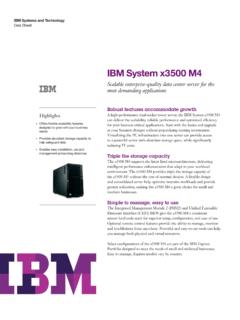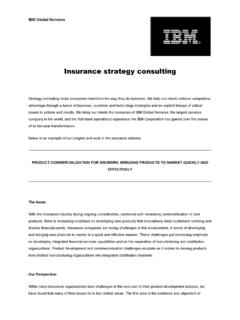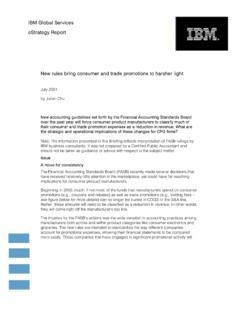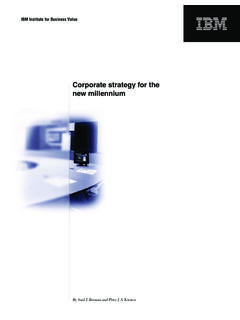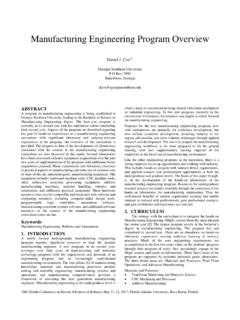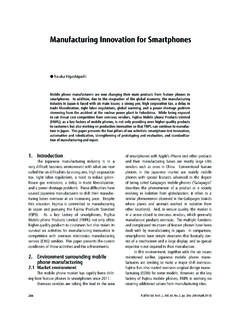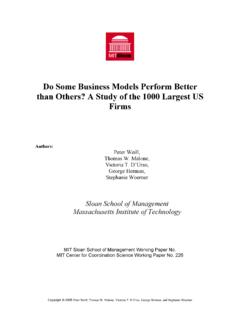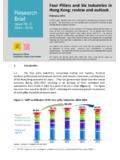Transcription of Operational excellence in manufacturing: How to win at the ...
1 White PaperDecember 2008 Operational excellence in manufacturing : How to win at the margins with business intelligenceOperational excellence in manufacturing : How to win at the margins with business intelligence2 IntroductionYour customers are ever more demanding, and margins for error are shrinking. With intense public scrutiny on product recalls and quality issues, anything less than perfection in any area a single missed shipment, a single product defect can have permanent consequences. Product quality, productivity and customer retention in short, the pillars of Operational excellence are critical to profitable manufacturing concerns. While strategies such as Six Sigma, lean manufacturing , continuous improvement and others will continue to drive management decisions, many manufacturers are placing a renewed focus on the fundamentals of execution. Operational excellence has emerged as the key to sustainable revenue and business is Operational excellence ? As defined by Michael Treacy and Fred Wiersema in a seminal Harvard Business Review article, Companies pursuing Operational excellence are indefatigable in seeking ways to minimize overhead costs, to eliminate intermediate production steps, to reduce transaction and other friction costs and to optimize business processes across functional and organizational boundaries.
2 1 Operational excellence is ultimately about delighting your customers and setting a new standard of performance in your industry. By focusing on the fastest and most efficient ways of satisfying your customers needs, the pursuit of Operational excellence will position you as the preferred supplier in your industry. This unwavering focus allows you to grow revenue with existing customers and to attract business away from your 3 Empowering Operations 4 The Value of Business Intelligence 5 Metrics Matter 5 The Operations Dilemma 7 Delivering on the Promise Made to the Customer Purchasing and Procurement Production and Capacity Inventory Management Distribution and Logistics Cost and Quality Management Process Efficiency 12 The Need for Visibility 13 Why Business Intelligence? 14 Get Everyone on the Same Page 15 Transforming Data Into Intelligence 16 Business and Operational Alignment with Scorecards and Dashboards Procurement excellence Production excellence Materials Management excellence 19 Summary The Right Technology and Solutions The Fastest Methods Performance Management ExpertsOperational excellence in manufacturing : How to win at the margins with business intelligence Operations is the delivery mechanism of the manufacturing enterprise, providing what the business sells and how that product gets to market.
3 It is an engine driving the work in purchasing, production, distribution, logistics and inventory management. That engine depends on input from the front line of the business sales, marketing and and outsourced production, technology-enabled process excellence and supply chain integration are part of the relentless drive for lower costs. After decades of investment in continuous improvement initiatives, manufacturing companies have achieved what major cost savings are possible. Managing and winning at the margins is the new competitive is why Operational excellence has become the driving force for the manufacturing enterprise. By providing a framework in which people and technologies can realize their full potential, Operational excellence empowers people throughout the business to be true performance managers by aligning action with business strategy. Empowering Operations Operational excellence is when each employee can see the flow of value to the customer and fix that flow when it breaks down.
4 It s that simple. Kevin Duggan, faculty member, Lean Enterprise Institute2 Operational excellence in manufacturing : How to win at the margins with business intelligence With the stakes so high in an unforgiving economic climate, it is not surprising that business leaders have been investing in technology to improve Operations. The question is no longer, Should I invest in improving Operations? Rather, it is, How can I invest in Operational excellence ? and How can I measure the effectiveness of these investments? To connect processes with performance goals, companies need business intelligence (BI) capabilities, including metrics, key performance indicators (KPIs), dashboards and advanced reporting. With the right BI solution, manufacturers can gain crucial visibility into performance and ensure Operations is functioning at peak levels. You can get a continuous view into key areas such as procurement, production and materials management. You can gain the ability to see problems as they happen, which means you can solve them quickly and guarantee they have a minimal effect on your business.
5 Even better, you can see trends developing, which allows you to take proactive action to prevent problems before they happen. This means you can solve problems quickly and guarantee they have a minimal effect on your s not all about solving problems, though. The right BI solution empowers you to prevent problems before they occur by monitoring, analyzing and reporting on business performance. It helps reduce costs, prevent losses, improve revenues and identify new, potentially profitable business Value of Business Intelligence Companies must go beyond just providing reports of basic Operational metrics to facilitating access, to be able to correlate process outcomes to corporate performance goals and apply Operational metrics to assure continuous process improvement. Ventana Research, Supply Chain Business Intelligence Adoption, Manufacturers that leverage BI technology to measure and monitor key performance indicators have an edge in managing their operations, according to the manufacturing Enterprise Solutions Association (MESA).
6 In a handbook entitled Metrics that Matter, MESA reported performance management applications such as dashboards have helped manufacturers improve significantly against both operations and business metrics. What we re talking about is manufacturers survival, said Julie Fraser, principal of Industry Directions, Inc., and the MESA study s consultant. If operations and finance aren t on the same page at the same time, you have a company at cross-purposes. And most manufacturers can t afford to be in that position today. 3 manufacturing managers recognize the importance of evaluating Operational decisions holistically. However, it is often difficult to link specific Operational practices to strategic outcomes and, in turn, to financial results. This presents challenges for both business and IT managers seeking to justify the cost of Operational improvement initiatives and performance management we explore the role of BI sin your pursuit of Operational excellence , let s take a closer look at what Operations does and what it is intended to excellence in manufacturing : How to win at the margins with business intelligence More than any other business discipline, Operations is responsible for heterogeneous activities and processes a multitude of activities and processes it must plan and manage, but does not directly one end, Operations works with a variety of suppliers and shippers to bring materials into the company.
7 It must inspect and store these materials and deliver them to production, all the while overseeing the smooth and efficient execution of the manufacturing processes. Finally, Operations must store and ship the finished products. At each step, Operations must plan and manage a multitude of MatterThe Operations DilemmaOperational excellence in manufacturing : How to win at the margins with business intelligence Operations must be able to react to a host of constantly changing factors. The environment is a dynamic one, always fluctuating. Operations must deal with changes in customer demand, shifting priorities, inventory shortages and unexpected events, capacities changing due to machine availability, and labor shortages (from sickness, vacations and so on). At times you might have to mandate overtime work in order to meet demand, but at a higher the entire production, supply chain and order-to-delivery cycle, Operations must know where everything is, when more is coming, how much is needed, when, where and what s supposed to be done with it.
8 Operations must be able to monitor production and make sure a quality, finished product gets to the customer, all the while negotiating with innumerable partners and navigating a myriad of environments and priorities. While the ideal is a smooth, end-to-end process, the reality is often rather short, Operations is a nuts and bolts world. Operational excellence in today s business environment means not only delivering efficiency and quality, but managing the supply chain across the board: from procurement to production to materials management to delivery. The crucial factor for success? Ensuring your information is completely cross-functional, treating the enterprise like a single body, a single entity that has intelligence throughout, in every detail, in every link of the supply chain. We see performance management as the proof point of supply chain activities. Without measurement procedures in place, companies have no way of knowing if all that money and effort spent on supply chain planning is doing any good.
9 Mark Vigoroso, Analyst, Aberdeen GroupOperational excellence in manufacturing : How to win at the margins with business intelligence For Operations to win at the margins, every day and every shift must balance the need to reduce costs while staying agile enough to respond to new customer demands. Operations has the responsibility to lead six core areas of the company s decision-making:Purchasing and procurement: Ensuring timely and cost-effective input of and capacity: Generating timely output in the face of uncertain demand, complicated processes and variances in management: Understanding the balance between holding cash and delivering on customer service and logistics: Achieving efficient distribution and and quality management: Balancing the need to reduce costs with the equal requirement to deliver quality efficiency: Designing a process to monitor and analyze performance benchmarks to find opportunities for greater efficiency. Purchasing and ProcurementThe purchasing and procurement decision area manages both input costs and supply requirements.
10 In many manufacturers, input costs account for up to 50 percent of total costs. For every one percent gained in input cost savings, somewhere between percent and percent typically will be earned as This is a significant return on investment when compared to other investments and project addition to cost, the procurement personnel must ensure inputs arrive in a timely manner. Inputs arriving too late threaten production and customer delivery; inputs arriving too early cause unnecessary inventory buildup. Managers must balance input costs with the production outputs required to satisfy customers. In the short term, your decisions must include how to respond to shortage problems, price increases and delivery delays. Long-term decisions include determining your supplier decisions require information on specifications, procurement tenders, price quotations and vendor performance assessments. The better you understand the trade-offs, the more finely tuned your ability to win at the on the Promise Made to the CustomerOperational excellence in manufacturing : How to win at the margins with business intelligence8 Without product, there is no business.

